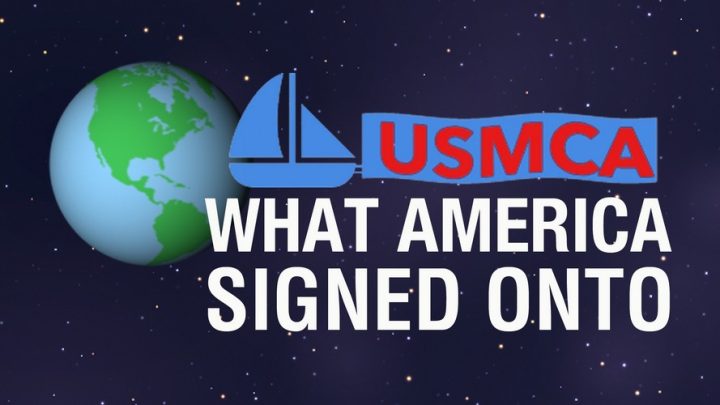
The first week of July is typically a joyful occasion, with Americans celebrating their nation’s independence on July 4 and Canadians celebrating Canada Day on July 1. This year, July 1 also marks the first day that the United States-Mexico-Canada Agreement (USMCA) goes into force, replacing the original 1994 North American Free Trade Agreement (NAFTA), and economically integrating the three countries one step closer toward a regional customs union.
The USMCA was inaugurated with much fanfare across the political spectrum, from House Speaker Nancy Pelosi to officials from Canada’s ruling Liberal Party. Canadian Deputy Prime Minister Chrystia Freeland, who served as Canada’s chief negotiator on the agreement, has repeatedly lauded it as a “progressive trade agreement” for its strong environmental and labor standards.
In a speech before Canada’s House of Commons, delivered on January 30, 2020, Deputy Prime Minister Freeland said of the USMCA: “And, when it comes into force, this agreement will be the most progressive trade deal our country has ever negotiated. Indeed, I believe it will be the most progressive trade deal in the world.” She further elaborated how it strengthens “State-to-State dispute settlement, labour protection, environmental protection, and rules of origin.”
Exploring just how progressive the new USMCA is and how it advances globalist designs for greater regional integration on the path toward one world government, The John Birch Society has released a brand new educational video entitled “USMCA: What America Signed Onto” to coincide with the trade scheme’s first day of entry into force.
The roughly 11-minute video details what’s in the 2,410-page USMCA and how it undermines America’s national sovereignty. As the video points out, according to the U.S. Constitution, Congress has the exclusive power “to regulate Commerce with foreign nations, and among the several States.” The Constitution further elaborates that “all duties, Imposts and excises shall be uniform throughout the United States.”
The framers of the Constitution intended for Congress to have the power to levy or lower tariffs whenever necessary. However, over the course of two centuries, that power was gradually transferred from Congress to the president and the Executive Branch, beginning with the Trade Agreements Act of 1934.
Among the most alarming items in the USMCA covered in the video are how it transfers power from Congress and the states to a new Free Trade Commission serving as administrative transnational body for the agreement; advances the liberal social agenda of “gender identity,” which has nothing to do with trade between nations; and how it threatens U.S. national sovereignty through the advancement of United Nations treaties and conventions that have never been ratified by the U.S. Senate.
For example, in Chapter 23 of the USMCA, under the section entitled “Sex-Based Discrimination in the Workplace,” the United States, Mexico, and Canada are required to “implement policies” guaranteeing workplace protections for “gender identity” and other LGBTQ “gender-related issues.”
According to Article 23.12 of the USMCA, all three countries agree to cooperate on “addressing gender-related issues in the field of labor and employment,” as well as “addressing the opportunities of a diverse workforce, including: … promotion of equality and elimination of employment discrimination in the areas of age, disability, race, ethnicity, religion, sexual orientation, gender identity.”
In other words, as the video points out, if a man applies for a job and goes to the interview dressed as a woman with a demand that he be addressed with female pronouns and demonstrates even the mildest capacity to do the job, the employer may be forced to hire that individual or run the risk of a lawsuit.
In fact, on June 15, 2020, a little over two weeks prior to the USMCA’s entry into force, the U.S. Supreme Court ruled 6-3 in Bostock v. Clayton County, Georgia that the 1964 Civil Rights Act also extends to protect gay and transgender employees from workplace discrimination. This ruling so happens to bring the United States into full compliance with the “gender identity” provisions in Chapter 23 of the USMCA.
Chapter 23 also requires all three countries to “adopt and maintain in its statutes and regulations, and practices thereunder … the effective recognition of the right to collective bargaining.”
In other words, the USMCA could force Congress to pass national “collective bargaining” laws, overturning any individual state’s “right to work” laws.
In fact, in 2019, Mexico’s Congress was compelled into doing just that, at the behest of Speaker Pelosi and Congressional Democrats, as a prerequisite for the U.S. Congress’ approval of the USMCA implementing legislation.
On the subject of regional integration toward a nascent North American Union, Chapter 26 of the USMCA, the competitiveness chapter, establishes a “Competitiveness Committee” made up of unelected government representatives from all three countries.
According to Article 26.1, Section 5 of the USMCA, the purpose of this Competitiveness Committee is to promote “economic integration and development within the free trade area” and “to further enhance the competitiveness of the North American economy.” (Emphasis added.)
This is extremely dangerous since the Competitiveness Committee has the ability to create an “economic union” by merging the economies of the United States, Mexico, and Canada into a North American Union akin to the European Union.
For those who wish to maintain the United States’ standing as a free and independent republic, the objectives of the Competitiveness Committee should be an area of major concern.
Another major sovereignty-tearing aspect of the USMCA is Chapter 30 and its establishment of a new “Free Trade Commission.” Similar to the European Commission that runs the European Union, the USMCA’s Free Trade Commission will act as the agreement’s “administrative” or “executive” body with the power to “consider proposals to amend or modify this Agreement.”
Should the Free Trade Commission evolve, in much the same way the High Authority of the European Coal and Steal Community became today’s European Commission of the European Union, it may eventually override or force the U.S. Congress, Mexico’s Congress of the Union, and Canada’s Parliament to rubber-stamp USMCA mandates in the name of fostering or deepening “economic integration.”
The USMCA Free Trade Commission may someday impose on the United States new laws, regulations, and standards in the areas of banking, currency, the environment, fishing, e-commerce, and labor — all of which are areas covered in the various chapters of the USMCA.
This Free Trade Commission will also be made up of unelected government representatives from all three countries. These representatives will not only oversee implementation of the USMCA’s numerous provisions, they will also oversee 19 subordinate committees, such as the aforementioned Competitiveness Committee. And each of the 19 subcommittees will be staffed by more unelected representatives.
As mentioned earlier, the video also addresses how aspects of various chapters of the USMCA bind the United States to following UN conventions and treaties, namely the 1969 Vienna Convention on the Law of Treaties and the controversial United Nations Convention on the Law of the Sea, better known as the Law of the Sea Treaty — neither of which the U.S. Senate has ratified.
The primary concern with the USMCA is not its impact on the U.S. economy, good or bad, but its ramifications for U.S. sovereignty. As stated in the video, “The United States can weather the storms of a bad economy or even a recession, but it cannot survive the loss of its sovereignty.”
For a more exhaustive list of what’s in the USMCA, the video points to The John Birch Society’s “USMCA Issues Index.” The USMCA Issues Index is a free downloadable PDF that alphabetically lists most of the USMCA’s major threats to U.S. sovereignty and freedoms with links to the actual chapters of the agreement. Many of these issues are also covered in The New American’s online article entitled “What’s Really in the USMCA?”
More proposed trade deals are on the horizon, such as an FTA with the United Kingdom and a separate agreement with the European Union similar to President Obama’s once-proposed Transatlantic Trade and Investment Partnership (TTIP), and the USMCA offers a glimpse of what to expect from those agreements, especially as they are also being negotiated by U.S. Trade Representative and CFR luminary Robert Lighthizer, who served as the United States’ principle negotiator for the USMCA.
Those concerned about preserving America’s liberty and independence can take action by using The John Birch Society’s federal legislative alert entitled “Get US Out! of the USMCA,” which allows one to send a prewritten, editable e-mail message, a tweet, and record a short 30-second video urging both President Trump and Congress to formally withdraw from the USMCA.
Image: jbs.org





